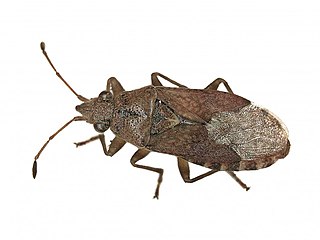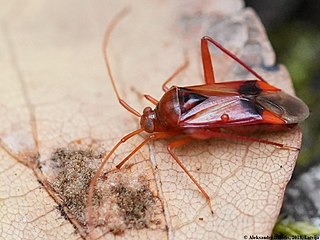
Pentatomidae is a family of insects belonging to the order Hemiptera, generally called shield bugs or stink bugs. Pentatomidae is the largest family in the superfamily Pentatomoidea, and contains around 900 genera and over 4700 species. As hemipterans, the pentatomids have piercing sucking mouthparts, and most are phytophagous, including several species which are severe pests on agricultural crops. However, some species, particularly in the subfamily Asopinae, are predatory and may be considered beneficial.

Tytthus is a genus of insects in family Miridae, the plant bugs. They are carnivorous, feeding upon the eggs of various planthoppers in the family Delphacidae, and thus are important in the biological control of pests. The genus is distributed throughout the Holarctic of the Northern Hemisphere, but species are also found in the tropics, in China, South America, Australia, and the Indo-Pacific.

Elasmostethus is a genus of shield bugs belonging to the family Acanthosomatidae.

Dipsocoridae are a family of heteropteran bugs known as jumping ground bugs. There are about 30 widely distributed species which are placed in three genera. Fossils from Eocene amber have also been placed in the family.

Orsillus is a genus of Palaearctic bugs, in the family Lygaeidae; it is the type genus of the subfamily Orsillinae and tribe Orsillini. Species are recorded from Europe and includes O. depressus which has become naturalised in the British Isles.

Enoplops is a genus of Palaearctic bugs, in the family Coreidae and tribe Coreini. Species are recorded from Europe and includes E. scapha found in the British Isles; there are also records from North Africa and China.

Podops is a genus of Palaearctic bugs, in the family Pentatomidae; it is the type genus of the subfamily Podopinae and tribe Podopini. Species are recorded from Europe and includes the type species P. inunctus, which can be found in the British Isles.

Campylosteira is a genus of lace bugs in the tribe Tingini. Species are recorded from Asia, Africa, North America and Europe and includes C. verna found in the British Isles.
Oncochila is a genus of lace bugs in the tribe Tingini. Species are recorded from temperate Asia and Europe and includes O. simplex found in the British Isles.
Platycranus is a genus of mostly European capsid bugs in the tribe Orthotylini, erected by Franz Xaver Fieber in 1858. The species P. bicolor has been recorded from the British Isles.
Zygimus is a genus of European capsid bugs in the tribe Mirini, erected by Franz Xaver Fieber in 1870. It is probably monotypic with records of Zygimus nigriceps from Scandinavia, northern England and Scotland.
Brachynotocoris is a genus of mostly European capsid bugs in the tribe Orthotylini, erected by Odo Reuter in 1880. The type species Brachynotocoris puncticornis is found in northern Europe, including the British Isles.

Megacoelum is a genus of European, African, Asian and Australian capsid bugs in the tribe Mirini, erected by Franz Xaver Fieber in 1858. The species Megacoelum infusum is recorded from northern Europe including the British Isles.
Tinicephalus is a genus of mostly European capsid bugs in the tribe Phylini, erected by Franz Xaver Fieber in 1858. The species Tinicephalus hortulanus is recorded from northern Europe including the British Isles.
Pseudomegacoelum is a genus of mostly European capsid bugs in the tribe Mirini, erected by Chérot and Malipatil in 2016. The type species, Pseudomegacoelum beckeri is recorded from northern Europe including the British Isles.
Pseudomegacoelum beckeri is a genus of capsid bugs in the tribe Mirini; it is the type species in its new genus, having previously been placed in the genus MegacoelumFieber, 1858. This species is widespread throughout Europe, including the British Isles, where it can be found on Scots pine: Pinus sylvestris.
Psallodema is a genus of mostly European capsid bugs in the tribe Phylini, erected by V.G. Putshkov in 1970. The species Psallodema fieberi is recorded from northern Europe including the British Isles.

Hadrodemus is a genus of mostly European capsid bugs in the tribe Mirini, erected by Franz Xaver Fieber in 1858. The type species Hadrodemus m-flavum is recorded from northern Europe including the British Isles.
Notochilus is a genus of mostly European bugs in the tribe Drymini, erected by Franz Xaver Fieber in 1864. The species Notochilus limbatus is recorded from northern Europe including the British Isles.









